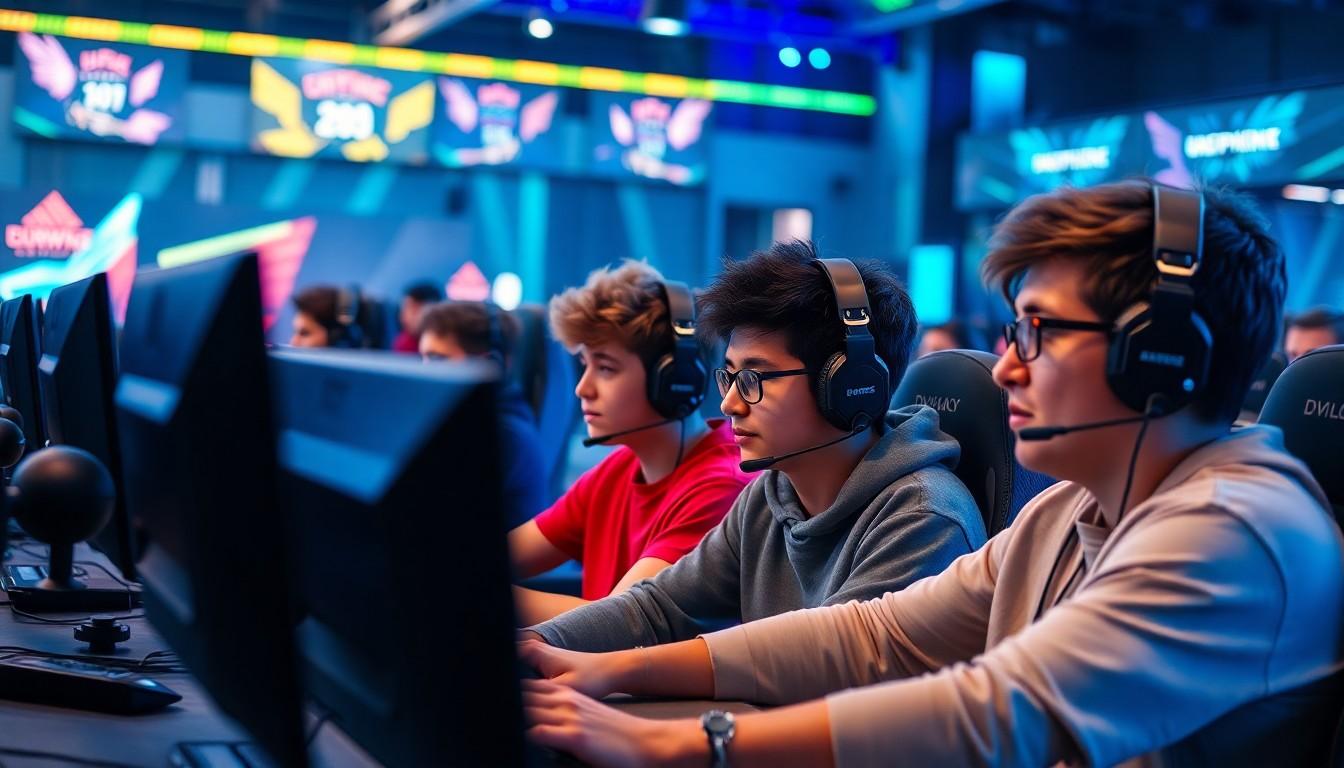Phone:
(701)814-6992
Physical address:
6296 Donnelly Plaza
Ratkeville, Bahamas.

In the fast-paced world of esports, where gamers become legends overnight and sponsors throw money like confetti, the right business strategies can make or break a team. It’s not just about having the best players; it’s about knowing how to market them, build a loyal fanbase, and turn those Twitch views into cold hard cash.
Understanding esports business strategies requires recognizing their diverse components. Marketing plays a pivotal role in promoting players and teams, aiming to capture audience attention effectively. Cultivating a devoted fanbase enhances engagement, creating lasting loyalty among viewers. Monetization strategies capitalize on various revenue streams, including sponsorships and merchandise sales.
Sponsorships generate significant income for esports organizations. Brands often seek partnerships with popular teams, which can lead to lucrative deals. Merchandise sales, including apparel and in-game items, further augment revenue streams while expanding brand visibility. Event organization remains another critical strategy; tournaments attract large audiences and offer opportunities for ticket sales and advertising.
Digital platforms serve as vital distribution channels. Twitch and YouTube encourage content sharing, allowing teams to showcase gameplay and interact with fans. Engaging content creation fosters a community atmosphere, making fans feel connected to their favorite players. Social media promotes real-time interactions, facilitating instant feedback from audiences.
Additionally, investment in technology and infrastructure accelerates growth. Organizations may leverage analytics tools to refine strategies, enhance performance, and prioritize targeted marketing. Esports teams often explore global expansion to tap into new markets, increasing their reach and cultivating international fanbases.
Diverse revenue models also contribute to success. Subscription services provide a steady income stream, while crowdfunding campaigns involve supporters in funding projects. With a comprehensive approach, esports organizations position themselves for long-term sustainability and growth in a competitive landscape.

The esports industry experiences rapid growth, driven by expanding audiences and diverse revenue opportunities.
Esports viewership continues to climb, with estimates projecting around 600 million global fans in 2023. Younger demographics, particularly those aged 18-34, dominate this audience, fostering a community around competitive gaming. Engaging content and live streaming platforms like Twitch facilitate easy access to tournaments, significantly boosting audience numbers. Major events attract millions of viewers, further enhancing the visibility of esports. Growth not only stems from traditional fans but also casual gamers exploring competitive gameplay. Diverse game titles across genres entice a wider range of participants, expanding fandom and engagement.
Revenue in the esports industry derives from various streams, ensuring robust financial health. Sponsorships lead the charge, providing essential funding as brands connect with eager fanbases. Partnerships with major corporations, including tech and beverage companies, drive substantial revenue. Merchandise sales contribute significantly, encompassing a range of products such as apparel and gaming peripherals. Ticket sales from tournaments create additional income while enhancing live event experiences for fans. Digital content monetization through platforms like YouTube and Twitch also plays a vital role. Subscription services and crowdfunding initiatives foster long-term sustainability, reflecting the industry’s versatility in generating income.
Esports organizations employ unique business strategies to thrive in a competitive landscape. Focus on effective methods allows for revenue generation and brand growth.
Sponsorships drive significant revenue within the esports sector. Brands partner with top teams to access their dedicated fanbases. Affiliations enhance visibility and create marketing opportunities for products. High-profile partnerships result in mutual benefits, as sponsors gain exposure while teams acquire funding. Companies often invest in promotional campaigns featuring esports athletes to leverage their popularity. Collaboration increases brand engagement through authentic connections with audiences. With projections indicating an audience of 600 million by 2023, sponsorships become crucial for capturing consumer interest.
Merchandise sales substantially contribute to an organization’s overall revenue stream. Teams often offer apparel and in-game items to fans, fostering loyalty and community. Strong branding enhances a team’s market presence and encourages merchandise purchases. Limited edition products create urgency, driving sales and increasing exclusivity. Social media plays a vital role in merchandise promotion, allowing teams to quickly showcase new items. Well-executed branding strategies improve recognition and create lasting impressions in the minds of consumers. Engaging visuals and targeted campaigns attract fans, ensuring that merchandise remains a key part of revenue generation.
Digital engagement techniques play a crucial role in the esports industry’s growth. Organizations leverage innovative strategies to connect with fans effectively.
Social media platforms provide essential tools for teams to engage with their audiences directly. Engaging content on platforms like Twitter, Instagram, and Facebook encourages interaction and builds a community. Real-time updates, such as player achievements and tournament highlights, keep fans informed and invested. Teams often run promotional campaigns to attract new followers and retain existing fans. Building relationships through personalized interactions strengthens loyalty, which is vital in a competitive landscape. Analysis of engagement metrics informs future strategies, allowing teams to refine their approach continually.
Streaming services like Twitch are pivotal for esports marketing. Players and teams showcase their skills live, attracting millions of viewers worldwide. Regular broadcasts of tournaments create excitement and build anticipation among fans. Content creation extends beyond gameplay, with behind-the-scenes footage offering fans a glimpse into players’ lives. Collaborations with popular streamers amplify reach and foster new audiences. Monetization through advertisements and subscriptions enhances revenue while keeping fans engaged. Multiple platforms work together seamlessly to drive visibility, ensuring esports organizations capitalize on growing interest in competitive gaming.
Projected growth in esports continues to accelerate, with viewership expected to approach 600 million fans globally by the end of 2023. Younger demographics, especially individuals aged 18 to 34, dominate this expanding audience. Revenue generation tactics will evolve, as sponsorships remain a vital source of income for esports organizations. Investors will increasingly recognize the value of brand partnerships with popular teams, which create mutual benefits.
Innovative revenue models will also shape the industry’s future. Subscription services and crowdfunding campaigns will expand, allowing teams to connect more deeply with dedicated fanbases. Merchandise sales will be crucial, with teams offering appealing apparel and in-game items that resonate with audiences. Strong social media branding and promotion efforts will support these initiatives, ensuring that teams maintain visibility and relevance.
Event organization strategies will adapt to the increasing demand for live competitions. Tournaments will draw substantial crowds, creating opportunities for ticket sales and advertising revenue. Digital platforms will play an essential role in distributing content, with services like Twitch and YouTube facilitating interaction between teams and fans. Engaging content will keep audiences informed and invested in ongoing events.
Investment in technology will drive further growth, as data analytics tools enhance performance and strategy refinement. Teams will focus on global expansion, tapping into emerging markets and cultivating international fanbases. Enhanced digital engagement techniques will remain a priority, leveraging social media platforms to foster community interaction and strengthen bonds between teams and their supporters.
Future esports strategies will emphasize the integration of various platforms, optimizing marketing efforts. The seamless approach to content distribution will capitalize on the surge of interest in competitive gaming. Collaboration with popular influencers will amplify reach, ensuring that esports organizations remain at the forefront of the industry.
The esports industry is rapidly evolving and demands innovative business strategies for sustained success. Organizations must prioritize effective marketing and fan engagement to build loyalty and drive revenue. By leveraging diverse revenue streams such as sponsorships and merchandise sales, teams can enhance their financial stability.
As viewership continues to grow and new markets emerge, teams should embrace technology and analytics to refine their approaches. Digital platforms will remain essential for content distribution and fan interaction. With a focus on community building and strategic partnerships, esports organizations are well-positioned to thrive in this dynamic landscape.